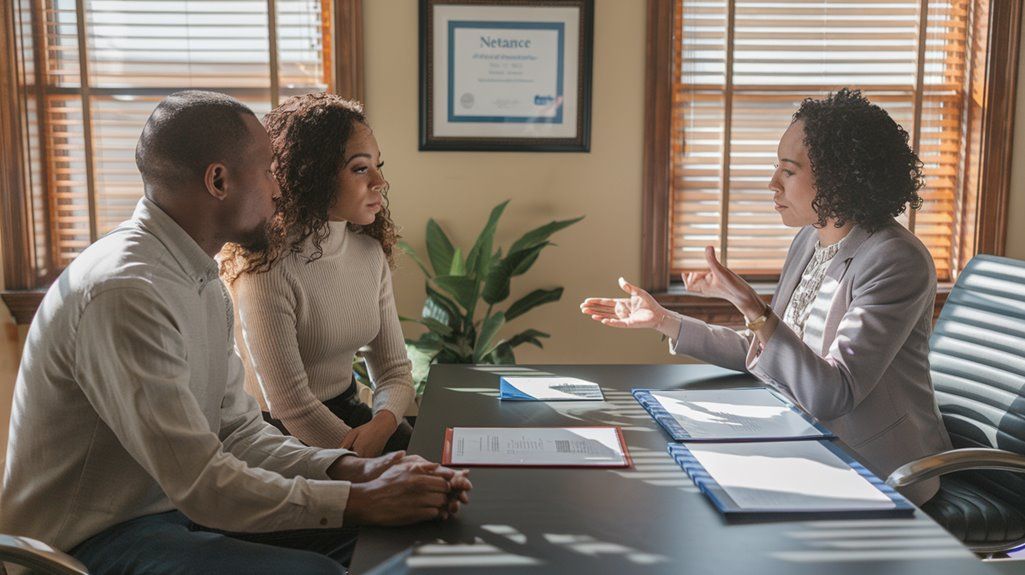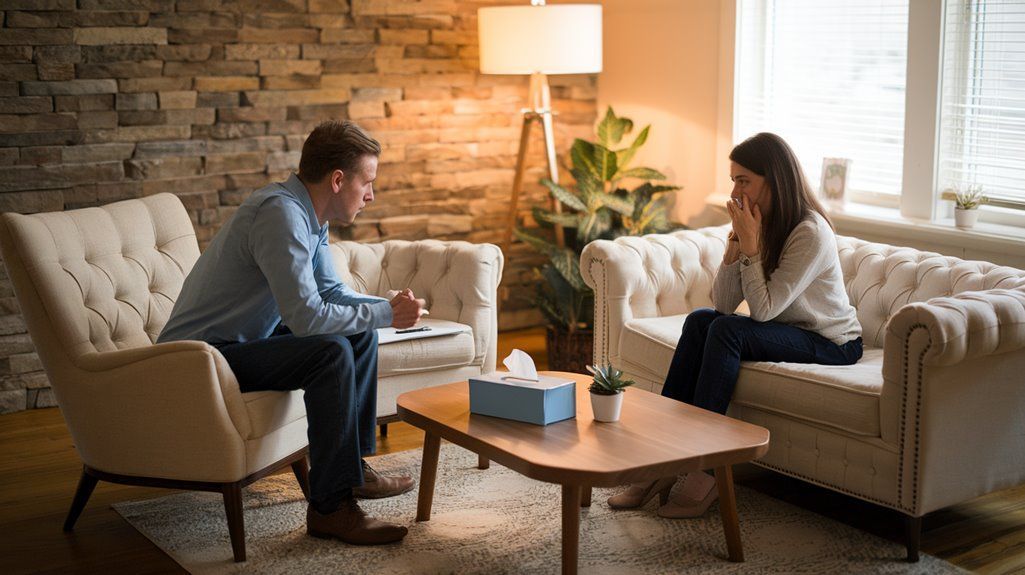How Can Therapists Successfully Incorporate New Members Into Family Therapy Sessions?
Share this article:

As a therapist, you're tasked with incorporating new members into family therapy sessions thoughtfully and effectively. Start by clearly establishing expectations and communicating the purpose of including new members, ensuring everyone's on the same page. Create a welcoming atmosphere, tailored to the family's unique needs, that fosters empathy and open communication. It's crucial to respect individual backgrounds while facilitating bonding through sharing experiences and feelings in a safe environment. Acknowledge the adjustment period and support each member, ensuring they feel heard and respected. Guiding your family through this transition with patience and understanding prepares the ground for deeper exploration and healing together.
Listen to the Article
Key Takeaways
- Clearly communicate the purpose and expectations of adding new members to ensure alignment and understanding.
- Establish ground rules for confidentiality and respectful communication to create a safe and trusting environment.
- Facilitate introductions and sharing of individual backgrounds to promote empathy and connection among all members.
- Address and navigate emotions related to adjustment and transition, ensuring each member feels heard and valued.
- Utilize engaging activities that cater to the diverse ages and interests of family members to foster bonding and cohesion.
Setting Expectations
Before integrating new members into family therapy sessions, it's crucial to clearly establish what everyone can expect from the process, setting a foundation for a constructive and supportive environment. As a therapist, you're not just a guide; you're a facilitator of understanding and growth. It's essential to communicate the purpose of including new members, whether they're stepparents, siblings, or any individual becoming part of the familial structure. This conversation lays the groundwork for mutual respect and openness, crucial elements in therapy.
You'll need to outline the boundaries and confidentiality rules that protect everyone's privacy and ensure a safe space for sharing. It's also important to discuss the goals of therapy openly. What does each member hope to achieve? Understanding these expectations helps you tailor the sessions to meet the family's unique needs.
Facilitating Bonding
As a therapist, you'll find that facilitating bonding among new and existing family members is a pivotal step towards healing and unity within the therapeutic process. This involves creating opportunities for each member to share their feelings and experiences in a safe and supportive environment. Your role is to guide these interactions in a way that fosters empathy, understanding, and respect among all participants.
Begin by encouraging open communication. Invite each family member to express their thoughts and feelings without judgment. This openness helps build trust and demonstrates the value of each person's perspective. Use exercises and activities that promote empathy, such as role reversal or shared storytelling. These techniques allow family members to see the world from each other's viewpoints, breaking down barriers and building connections.
It's also essential to acknowledge and celebrate the uniqueness of each family dynamic. Highlighting individual strengths and contributions reinforces a sense of belonging and appreciation within the group. Remember, your objective isn't to eliminate differences but to weave these diverse threads into a stronger familial tapestry.
Creating a Welcoming Environment
Creating a welcoming environment in family therapy sessions is crucial to ensure every member feels safe, valued, and ready to engage in the healing process. As a therapist, you've got a unique role in not just facilitating discussions but also in crafting a space that speaks comfort and trust from the moment a new member steps in.
Start by personalizing the session space. A room that's both professional and warm can significantly lower initial barriers of discomfort. Think soft lighting, comfortable seating, and minimal clutter. These elements signal a safe zone for emotional expression.
Communication is your next powerful tool. Greet each member with genuine warmth and interest. Ensuring everyone's names are pronounced correctly and preferences are respected goes a long way in showing you care about their individuality.
Your demeanor plays a huge part, too. Maintain open body language and an encouraging tone throughout. This non-verbal communication reinforces your verbal welcome, helping new members feel they're in a supportive and non-judgmental space.
Lastly, confidentiality is paramount. Emphasize the importance of privacy and the safe space you're committed to maintaining. This assurance lets family members know they can share openly without fear, fostering a truly welcoming environment for healing to begin.
Acknowledging Adjustment Periods
It's essential to recognize that every family member will experience an adjustment period as they acclimate to the dynamics of therapy sessions. This time of transition, while sometimes challenging, is a natural part of the process when integrating new members into therapeutic work. As a therapist, you play a crucial role in facilitating this adjustment, ensuring that each individual feels heard, validated, and respected throughout their journey.
Remember, it's not just about the new members adjusting; the existing family dynamics are also shifting. This can stir up a range of emotions, from excitement and curiosity to apprehension and resistance. Your task is to navigate these waters with a steady hand, offering a safe space for all feelings to be expressed and explored.
Patience is your ally here. Adjustments don't happen overnight, and pushing too hard can lead to setbacks. Instead, encourage open communication, fostering an environment where each person can share their experiences and concerns without fear of judgment.
Respecting Individual Backgrounds
Recognizing the unique backgrounds of each family member enriches the therapeutic process, enhancing understanding and empathy within the family dynamic. As a therapist, it's crucial to delve into the individual stories, beliefs, and experiences that each person brings into the room. This respect for diversity acts as a bridge to more meaningful connections and paves the way for effective communication.
You'll find that when you actively listen and show genuine interest in a person's background, they feel valued and understood. This is especially important in a family therapy setting where the interplay of different perspectives can either facilitate healing or deepen divides. Encourage family members to share their viewpoints and experiences without fear of judgment. This openness leads to a richer, more nuanced understanding of the family's challenges and strengths.
Establishing New Norms
As a therapist, you'll find that establishing new norms within a family requires patience, understanding, and a collaborative effort from all members. It's about crafting a shared environment where each individual feels heard, valued, and part of the collective journey. This process involves recognizing and honoring the unique contributions and needs of each family member, including new additions, to foster a sense of belonging and mutual respect.
Start by setting clear communication guidelines that encourage open, honest, and respectful dialogue. It's essential to cultivate an atmosphere where everyone is comfortable expressing their feelings, concerns, and expectations without fear of judgment. Encourage the family to develop rituals or traditions that include all members, thereby weaving the fabric of a new, inclusive family identity. These could range from weekly family meetings to special celebrations of each member's milestones.
In this dynamic, your role as a therapist is to facilitate discussions that help identify and negotiate the family's values, rules, and roles in this evolving landscape. It's about guiding them through the process of adapting to these changes in a way that strengthens their bonds and ensures that everyone feels supported and connected. Through empathy, professionalism, and a keen understanding of family dynamics, you can help lay the groundwork for a harmonious and resilient family unit.
Involving Everyone in Activities
As you navigate incorporating new members into family therapy sessions, selecting activities that engage everyone is crucial.
You'll want to establish open communication rules that ensure each person feels heard and valued.
It's equally important to foster a safe environment where all members can express themselves freely and without judgment.
Choose Engaging Group Activities
Selecting group activities that captivate and include all family members can significantly enhance the dynamics and outcomes of family therapy sessions. By carefully choosing exercises that encourage participation from everyone, you're not just facilitating interaction; you're also fostering a sense of unity and understanding within the group.
It's crucial to consider the ages, interests, and emotional states of all participants to ensure the activities are accessible and engaging for each member. Whether it's through art projects that express individual feelings while contributing to a collective masterpiece, or interactive games that build communication and trust, these shared experiences can bridge gaps and strengthen bonds.
Your role in guiding these activities with sensitivity and insight can make all the difference in creating a cohesive and supportive family environment.
Establish Open Communication Rules
Building on the foundation of engaging group activities, it's important to also establish open communication rules that ensure every family member feels heard and valued during therapy sessions.
Crafting these rules together fosters a sense of ownership and respect among all participants. It's vital you encourage each person to express their thoughts and feelings without fear of judgment or interruption. This practice not only promotes honesty and transparency but also helps in identifying underlying issues more effectively.
Foster a Safe Environment
Creating a safe environment requires actively involving every family member in therapeutic activities, ensuring they feel included and respected throughout the process. It's crucial to foster an atmosphere where each person can share without fear of judgment or disregard.
By incorporating activities that require collaboration and reflection, you're not just engaging them; you're also teaching valuable communication and empathy skills. Remember, it's your role to guide these interactions, subtly ensuring that everyone's voice is heard.
This approach not only helps in smoothing the integration of new members but also strengthens the family's bond as a whole. Your sensitivity, attentiveness, and professionalism pave the way for a transformative experience that resonates with every participant, building a foundation of trust and mutual respect.
Addressing Jealousy and Rivalry
As you navigate through family therapy sessions, it's crucial to acknowledge that feelings of jealousy and rivalry can surface, reflecting deeper emotional needs.
By recognizing the signs of jealousy, you're equipped to address these feelings head-on, using targeted techniques to mitigate rivalry and foster a nurturing environment.
Encouraging positive dynamics within the family sets the stage for stronger, more resilient relationships.
Recognizing Signs of Jealousy
Identifying signs of jealousy in family dynamics is crucial for nurturing healthier relationships and mitigating rivalry. As you delve into the fabric of family interactions, it's essential to discern subtle cues that may indicate underlying jealousy.
Here are three signs to watch for:
- Withdrawal from Family Activities: A member may start avoiding family gatherings or seem disinterested in shared activities, hinting at feelings of exclusion or resentment.
- Increased Irritability or Criticism: Pay attention to sudden changes in behavior, especially increased irritability or criticism towards a specific family member, which can be a manifestation of jealousy.
- Comparison Statements: Listen for statements that compare achievements, attention, or affection, as these often reveal feelings of inadequacy or competition.
Recognizing these signs with empathy and professionalism paves the way for addressing deeper issues, fostering a supportive environment for all family members.
Techniques to Mitigate Rivalry
After recognizing signs of jealousy, it's important to explore effective techniques that can help mitigate rivalry and foster a supportive atmosphere within the family.
You can initiate open discussions, allowing each member to express their feelings and concerns. This transparency helps in validating everyone's emotions, making them feel heard and understood.
Implementing family activities that require teamwork can also be beneficial. These activities encourage cooperation, highlighting each person's strengths and promoting a sense of unity.
Additionally, setting clear boundaries and rules regarding respectful behavior is crucial. It's vital to consistently reinforce these boundaries, ensuring that all family members feel safe and valued.
Encouraging Positive Family Dynamics
To foster positive family dynamics, it's crucial to address underlying feelings of jealousy and rivalry through open, empathetic communication and shared experiences. As a therapist, guiding families to navigate these emotions can transform their interactions.
Here's how you can encourage this positive change:
- Facilitate Family Meetings: Regular, structured meetings where each member can voice their feelings and concerns without interruption.
- Promote Team-Building Activities: Choose activities that require cooperation and highlight each member's strengths, fostering a sense of unity and appreciation.
- Model and Teach Empathetic Listening: Show by example how to listen with empathy, validating each person's feelings and perspectives.
These steps, when implemented with care and consistency, can significantly reduce jealousy and rivalry, leading to healthier, more supportive family dynamics.
Frequently Asked Questions
How to Handle Confidentiality With New Family Members?
You'll want to start by clearly explaining confidentiality rules and how they apply to everyone in the session. It's crucial to ensure each member understands and agrees to these terms to maintain trust and openness.
Can Pets Join Family Therapy Sessions?
You can include pets in family therapy sessions, as they often bring comfort and reduce stress. It's important, however, to ensure everyone's comfortable with the arrangement and to consider any allergies or fears.
Are Virtual Sessions Effective for New Members?
Yes, virtual sessions can be a game-changer for new members, offering unparalleled flexibility and comfort. They break down barriers, ensuring everyone feels heard and valued, fostering a safe space for profound growth and connection.
How to Reintegrate Members After Long Absences?
To reintegrate members after long absences, you'll need to create a welcoming environment that acknowledges their past participation while facilitating new connections. It's crucial to listen actively and validate everyone's feelings throughout this sensitive process.
What if a New Member Refuses Therapy?
If a new member's hesitant about therapy, it's key to listen and validate their feelings. Gently explore their concerns, offer information on therapy's benefits, and assure them they're in a safe, supportive environment.
Connect with Us:
Connect with Us:



